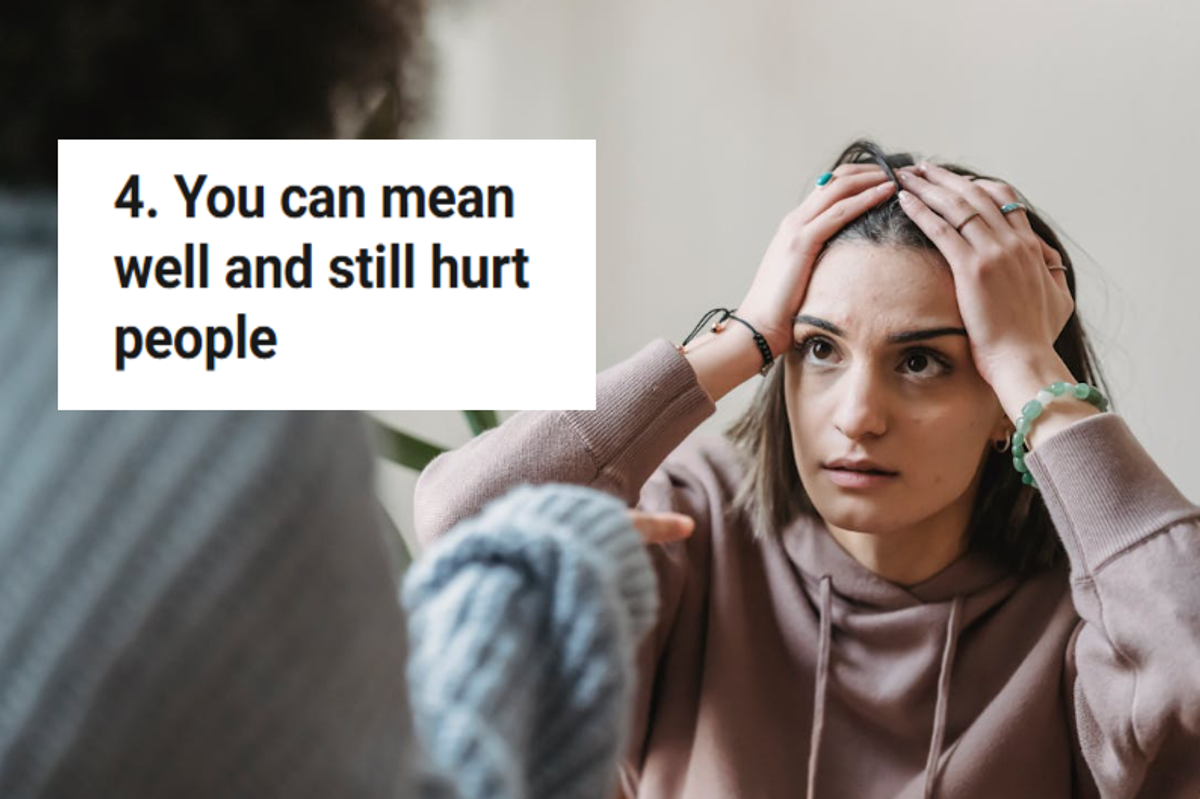Someone criticized a middle school teacher's behavior. Her comeback was an A+.
When a person commented, "your a teacher act like it," Amy Allen hilariously took the advice to heart.

A rude commenter got a lesson from Ms. Allen.
Being a teacher isn't easy. Teaching middle school students is especially not easy. Teaching middle school students who spent several of their formative years going through a global pandemic in the age of smartphones, social media and a youth mental health crisis is downright heroic.
If you haven't spent time in a middle school classroom, you may not fully grasp the intensity of it on every level, from the awkwardness to the body odor to the delightful hilarity that tweens bring to the table. When you connect with your students, it can be incredibly rewarding, and when you don't…well, we all read "Lord of the Flies," right?
Skilled teachers bring out the best in young people, and that can be done in many different ways. For Amy Allen, it's by making her middle school classroom a fun, welcoming place to learn and by bonding with her students.
"I love teaching middle schoolers because they are awkward, and I’m awkward, so we get along," Allen tells Upworthy.
She plays games with students, gets rambunctious with them and creates opportunities for them to expend some of that intense pre-and-early-teen energy in healthy ways. For instance, she shared a video of a game of "grudgeball," an active trivia game that makes reviewing for a quiz or test fun and competitive, and you can see how high-energy her classroom is:
@_queenoftheclassroom If this looks like fun to you, pick up my grudgeball template (🔗 in bio) #qotc #grudgeball #10outof10recommend @Amy Allen ☀️ @Amy Allen ☀️ @Amy Allen ☀️
"I think for teachers, we always want to create moments for our students that are beyond the standard reading, writing, memorizing, quiz, 'traditional learning,'" Allen says. "Games are a great way to incorporate fun in the classroom."
Allen clearly enjoyed the game as much as her students—"I love the chaos!" she says— and there's absolutely nothing wrong with that. Fun keeps teachers sane, too. But one person took issue with her classroom behavior and commented, "your a teacher act like it." (Not my typo—that's exactly what the person wrote, only with no period.)
Allen addressed the comment in another video in the most perfect way possible—by acting exactly like a teacher.
Watch:
@_queenoftheclassroom Replying to @كل الكلبات تريد مني Come see me if you have any further questions. #qotc #iteachmiddleschool #weDEFINITELYdonthavefuninhere @Amy Allen ☀️ @Amy Allen ☀️ @Amy Allen ☀️ #Inverted
There are two solid ways to handle a rude comment without making things worse—you can ignore it or you can craft a response that makes the person look like a fool without being cruel or rude yourself. Allen's grammar lesson response was A+ work, right down to the "Come see me if you have any further questions" caption.
In fact, the person apparently went back and deleted their comment after the comeback video went viral, which makes it all the more hilarious. The video currently has more than 4 million views on TikTok and over 18 million views on YouTube.
"What’s funny is I left my correction on the board accidentally, and the next day, students asked me what that was all about," Allen says. "When I explained it, they thought it was cool because 'why would anyone go after Ms. Allen'? At that point, the video had maybe 10,000 views. I never imagined the video would go viral."
Two days later, as the video was creeping toward a million views, she upped the stakes. "Some of my students are my ultimate hype people, and they were tracking it harder than I was," she says. "I made a 'deal' with my fifth period if it reached 1 million during their class, they could sit wherever they wanted the entire week. During lunch, I checked, and it reached 1 million. So when they came back from recess, I announced it, and it was like I was a rockstar. They screamed and cheered for me. It was an incredible moment for me."
The irony, of course, is that Allen was acting like a teacher in her grudgeball video—an engaged teacher with engaged students who are actively participating in the learning process. Just because it doesn't look like serious study doesn't mean it's not learning, and for some kids, this kind of activity might be far more effective at helping them remember things they've learned (in this case, vocabulary words) than less energetic ways of reviewing.
Allen has her thumb on the pulse of her students and goes out of her way to meet them where they are. Last year, for instance, she created a "mental health day" for her students. "I could tell they were getting burnt out from all the state tests, regular homework, and personal life extracurricular activities that many of my students participate in," she says. "We went to my school library for 'fireside reading,' solved a murder mystery, built blanket forts, watched the World Cup, colored, and completed sudokus. Is it part of the curriculum? No. Is it worth spending one class period doing something mentally rewarding for students? Absolutely."
Teaching middle school requires a lot of different skills, but perhaps the most important one is to connect with students, partly because it's far easier to teach someone actually wants to be in your classroom and partly because effective teaching is about so much more than just academics. A teacher might be the most caring, stable, trustworthy adult in some students' lives. What looks like silly fun and games in a classroom can actually help students feel safe and welcomed and valued, knowing that a teacher cares enough to try to make learning as enjoyable as possible. Plus, shared laughter in a classroom helps build a community of engaged learners, which is exactly what a classroom should be.
Keep up the awesome work, Ms. Allen, both in the classroom and in the comment section.
You can follow Amy Allen on TikTok and YouTube.
This article originally appeared last year.
- Teacher tries to simulate a dictatorship in her classroom, but the students crushed her ›
- Teacher mispronounces every student's name to get a laugh, but it also serves a bigger purpose ›
- People are sharing things teachers did in the '80s and '90s that would 'never fly' now ›
- Therapists share the 6 best comebacks to being insulted - Upworthy ›
- Shocked parent discovers airline has moved toddler's seat - Upworthy ›
- Mom admits she dreads going to her parent-teacher conference - Upworthy ›




 An upset woman sits in her car.via
An upset woman sits in her car.via  An upset man grabs his head.via
An upset man grabs his head.via  A stressed-out woman.via
A stressed-out woman.via 
 Meatloaf was a staple dinner.
Meatloaf was a staple dinner. Spaghetti is still a classic.
Spaghetti is still a classic. Why were pork chops so popular?
Why were pork chops so popular?
 David Bowie on swing in red suit
David Bowie on swing in red suit David Bowie album cover
David Bowie album cover Prince
Prince
 We really wish this were true. via @bryaninmsp/
We really wish this were true. via @bryaninmsp/